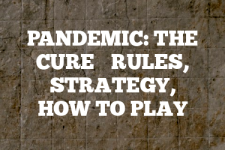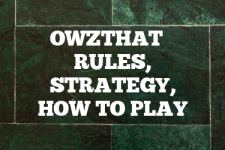Mia: A Guide to Dice Game – Rules, Instructions, Strategy Tips
Introduction
Mia is a dice game that I’ve played a lot. It’s a game of bluffing and luck, and it’s been around for a long while. Some people say it has roots in Germany, or even by northern peoples in 12th century Scandinavia, but I’ve definitely heard of folks playing it all over the world. The game is simple to learn but can get pretty intense. You only need a couple of dice and a way to hide your roll from the other players. I find it quite similar to Liar’s Dice, which I’ve also written a guide on.

The goal is to trick your opponents into believing you’ve rolled something you haven’t, or to call their bluff when they’re trying to pull one over on you. It’s a great game for a group of friends looking to have a good time.
Quick Tip for Mia
Always keep a straight face – your ability to bluff and detect bluffs is key!
Rules for playing Mia
The rules for Mia are pretty straightforward. Each player takes turns rolling the dice in a cup, then slamming it down on the table so no one else can see. You peek at your roll and declare what you have. The catch is, you can tell the truth or lie about it. The next player can either believe you and roll to try and get a higher combination, or call your bluff. If they call you out and you were lying, you lose a point. But if you were telling the truth, they lose a point. The dice have a ranking order, with 21, or Mia, being the highest roll. The game goes on until someone runs out of points.
To work out the score in Mia, you do it by combining the numbers they land on into a two-digit value. To clarify, the higher roll is multiplied by ten and then added to the lower roll. For instance, if the dice show 1 and 5, the resulting value is 51, not 15.
- The highest achievable value is 21, known as the Mia.
- Following the Mia, double-digit values descend from 66 to 11.
- Subsequently, the remaining values decrease in order of numerical magnitude from 65 down to 31. Any other number combination is deemed invalid.
Equipment and Setup for Mia
To play Mia, you need two dice and a cup for rolling. Each player starts with a set number of lives, usually six. You’ll also need a way to keep track of everyone’s lives. You can use coins, tokens, or just write it down. To set up, everyone sits in a circle, and you decide who goes first. It’s usually the person who suggests playing the game.
How to Play Mia
Playing Mia involves a few key steps. Here’s how a typical game goes:
- Rolling: The first player rolls the dice in the cup, slams it down, and peeks at the roll.
- Claiming: They then claim a roll. It could be the truth or a lie.
- Decision: The next player decides whether to challenge the claim or roll themselves.
- Revealing: If challenged, the first player reveals their roll. Points are lost accordingly.
- Continuing: Play continues to the next player, and the process repeats.
The game ends when one player loses all their lives.
Players sit, usually in a circle. The first player rolls the dice and publicly announces the resulting value before passing the dice to the next player. Here’s where strategy comes into play:
- If the next player believes the announced value, they must roll the dice and declare a value higher than the previous one.
- Or, if they doubt the accuracy of the announced value, they can challenge it. If proven correct in their challenge, they earn a point. Otherwise, the player who made the false announcement gains a point. The game proceeds with a new round thereafter.
A special note regarding the Mia: it carries double the point value, making it a crucial factor in gameplay.
The game continues until a player accumulates a predetermined number of points, such as 5, resulting in their elimination. Overall, I find it to be a pretty fun game of luck, strategy and bluffing.
How to Win at Mia
Winning at Mia requires a mix of good luck with the dice and, as I mentioned, being able to bluff well. You also need to be good at reading people. If you can tell when someone is lying, you can call their bluff. But be careful, if you call someone’s bluff and they’re telling the truth, you’ll lose a life. It’s also important to remember the rankings of the dice rolls. Knowing what beats what is crucial to making smart decisions during the game.
Best Strategies for playing Mia game
There are a few strategies that can help you win at Mia. First, it’s good to be unpredictable. If you always lie or always tell the truth, other players will catch on. Mix it up to keep them guessing. Another strategy is to pay attention to how other players react when they look at their roll. Sometimes you can pick up on little hints that they’re lying. Lastly, it’s sometimes worth taking a risk and calling someone’s bluff. If you’re right, you can knock them down a point and get closer to winning.
Variations
There are a few variations of Mia that can make the game even more interesting. Some people play with different life totals, or with special rules like “reverse Mia” where the lowest roll wins. You can also add more dice for a more complex game.
Scenarios
In Mia, you might find yourself in a tough spot, like if someone claims Mia right off the bat. Do you call their bluff? It’s risky, but it could pay off. On the other hand, if you’ve rolled a high number, you might want to bluff and claim a lower number to lure others into challenging you. It’s all about reading the situation and making the best move.
Frequently Asked Questions about playing Mia game
- Q: What happens if I roll the dice outside of the cup?
A: Usually, you have to re-roll so that it’s fair to everyone. - Q: Can I change my claim if I accidentally say the wrong thing?
A: It depends on who you’re playing with, but usually, your first claim is what you have to stick with. - Q: Is there any way to prevent cheating?
A: The best way is to make sure everyone slams the cup down hard enough that the dice can’t be moved after the fact.
External Links
Ancient History of Mia Dice Game

A digital native around since the early days of online gaming communities around 2001. An early contributor to the cult gaming site ClanTemplates, Adam has spent years giving free gaming resources to the community. With BoardCards, Adam is most experienced and commonly writing the articles on Strategy multi-player games like Settlers of Catan and Avalon. His first introduction to board games was via Mancala, an Egyptian-origin stone game and one of the oldest known games still played worldwide. Contact me via email



